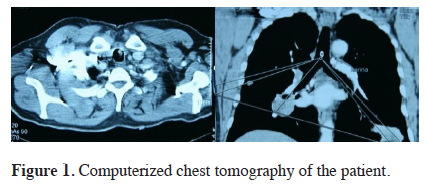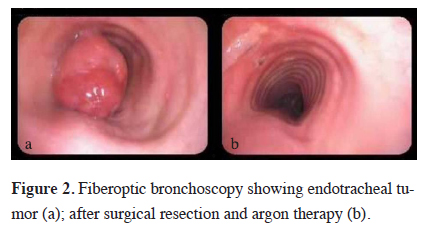

2Department of Allergy-Immunology, School of Medicine, Koç University Hospital, İstanbul, Turkey
3Department of Chest Disease, İstanbul School of Medicine, İstanbul University, İstanbul, Turkey
4Department of Thoracic Surgery, İstanbul School of Medicine, İstanbul University, İstanbul, Turkey DOI : 10.26663/cts.2016.0007
Summary
A 57-year-old male patient was admitted to our department with symptoms of dyspnea and hemoptysis, followed by a spontaneous expectoration of a small piece of solid tissue. He had two operations 13 and 3 years ago for perineal leiomyosarcoma and was on intermittent chemotherapy regimen until last year. Computerized chest tomography revealed an endotracheal mass with multiple metastatic nodular lesions at both lung fields. The pathologic examination of the expectorated tissue was found to be consistent with the metastasis of leiomyosarcoma. Solid polypoid endotracheal lesion adherent to the anterolateral wall and obstructing 70% of trachea was excised with the rigid bronchoscopy and argon laser.Introduction
Leiomyosarcoma is an uncommon malignancy usually arising in the uterus or in the retroperitoneum which tends to metastasize to the lungs and liver. The trachea is rarely affected and tumor expectoration is an unusual presentation. In unusual circumstances bronchoscopy reveals an endobronchial polypoid lesion without involvement of the bronchial wall. These lesions could be excised by a rigid bronchoscopy. As they tend to be refractory to either chemotherapy or radiotherapy resection is needed immediately for palliation [1-5].In this case report we present the successful treatment of a rare case of expectorated metastatic leimyosarcomas excised with rigid bronchoscopy and argon laser.
Case Presentation
A 57-year-old male patient was admitted to our department with symptoms of dyspnea and spontaneous expectoration of a small piece of solid tissue. He had two operations for perineal leimyosarcomas thirteen and three years ago and was on intermittent chemotherapy treatment with imatinib mesylate until last year, which was discontinued because of his intolerance. Two years ago parenchymal lung metastases were detected but they were steady without progression. His vital signs were normal. Physical examination revealed diminished breathing sounds in the both lower lung area and an incisional scar on his perineal region. He was unable to perform pulmonary function tests. His blood chemistry and hematologic studies were normal. Chest X-ray revealed multiple nodules in both lungs but computerized chest tomography revealed an endotracheal mass with multiple metastatic nodular lesions at both lungs (Figure 1). These findings were confirmed with a virtual bronchoscopy. The pathologic examination of the expectorated tissue was found to be metastasis of leiomyosarcoma. The specimen"s immunohistochemical stains for actin, vimentin, were positive but desmin, keratin, S100, and CD34 were negative.
 Click Here to Zoom |
Figure 1: Computerized chest tomography of the patient. |
Fiberoptic bronchoscopy under local anesthesia revealed a large, white, glistening endotracheal lesion arising from the left anterolateral wall and obstructing %70 percent of the trachea (Figure 2a). With general anesthesia, a rigid bronchoscopy was performed and the lesion was successfully excised and argon coagulation was applied for hemostasis (Figure 2b). The specimen showed the identical pathology with the previous expectorated tissue. The patient had no complications, has recovered from is symptoms and was discharged from our clinic the next day. Two weeks after treatment, trachea was confirmed to be normal.
 Click Here to Zoom |
Figure 2: Fiberoptic bronchoscopy showing endotracheal tumor (a); after surgical resection and argon therapy (b). |
Discussion
Primary neoplasms of the trachea are rare, in contrast to the larynx and the bronchial tree. Most common types of secondary tracheal tumors are infiltrating esophageal and thyroid cancers, or infiltrating lymph node metastasis [1]. Many variants of pulmonary metastasis could not be noticed with almost all kinds of malignant neoplasms. Extrapulmonary sources of endotracheal metastasis are very less common than pulmonary metastasis. Malignant neoplasms which could make metastasis to trachea are breast, colorectal, and renal neoplasms [2-3]. Metastatic leiomyosarcoma occasionally is seen with gross endobronchial extension without invasion of the bronchial wall. These patients have major airway obstruction and partial or total atelectasis of the lung [4]. Gynecologic leiomyosarcoma are uncommon malignancies. Although pulmonary metastases are frequent complications, endobronchial metastases are rare [5]. However, we have only two metastatic tracheal neoplasm patients (other one was colorectal metastasis to trachea) from 1997 on our department and working as a specific clinic as thoracic surgery. We performed a pubmed research with the key words of endotracheal, hemoptysis, dyspnea and leiomyosarcoma. We have found only 2 endobronchial - not endotracheal - metastasis of leiomyosarcoma [4,5]. We performed an endotracheal treatment on this lesion and a tracheal approach for palliation using both fiberoptic and rigid bronchoscopy. We did not achieve a complete treatment since there were also pulmonary nodules but palliated and helped him breathing well and have a comfortable life. We believe that metastatic scan should be done carefully all over the body periodically; and should be taken care of immediately. Pulmonary metastases of leiomyosarcoma that he had, were uncountable number of nodules on both lung fields. The patient refused a chemotherapy treatment but nodule was excised and he is still doing well now for 12 months.As a conclusion, the patients who had leiomyosarcoma neoplasms should be evaluated for endotracheal metastasis in case of acute airway obstruction. These lesions could be resected safely by endotracheal approach.
Declaration of conflicting interests
The author declared no conflicts of interest with respect to the authorship and/or publication of this article.
Funding
The author received no financial support for the research and/or authorship of this article.
Reference
1) Krausser H, Skuballa A. Endotracheal neoplasm of a 16-year-old boy: Extremely rare primary localisation of a B-cell non-Hodgkin's lymphoma. Pneumologie 2003; 57: 208-11.
2) Watanabe S, Oda M, Ohta Y, Watanabe G. Endotracheal metastasis of rectal cancer. Eur J Cardiothorac Surg 2002; 21: 924.
3) Nguyen BD, Ram PC, Roarke MC. Endotracheal metastasis from squamous cell cancer of the head and neck: PET/CT imaging. Clin Nucl Med 2008; 33: 340-1.



